Produced by Graflex
in Rochester, New York, the Speed Graphic is called the most famous press camera ever produced. Although the first Speed Graphic cameras were produced in 1912, production of later versions continued until 1973; with the most significant improvements occurring in 1947 with the introduction of the Pacemaker Speed Graphic (and Pacemaker Crown Graphic, which is one pound lighter but lacks the focal plane shutter). It was standard equipment for many American press photographers until the mid-1960’s.
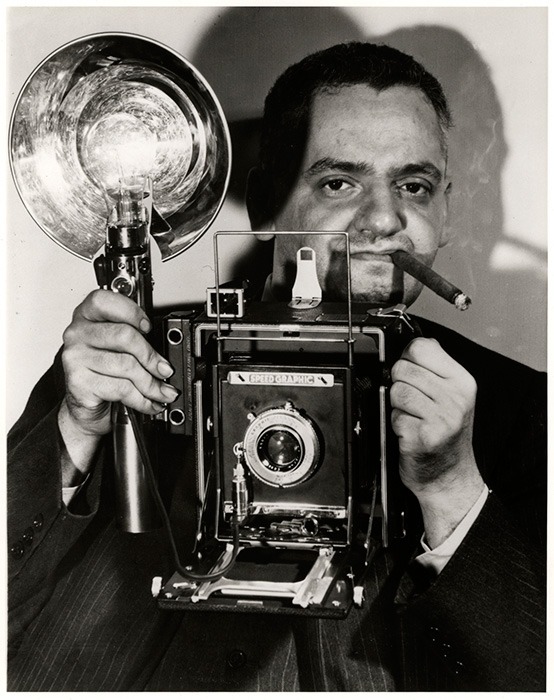
Speed Graphic – Mainstream 4×5
Various Graphic models were produced between 1912 and 1973. The authentic Speed Graphic has a focal plane shutter that the Crown Graphic and Century Graphic models lack. The eponymous name “speed” came from the maximum speed of 1/1000 second, that could be achieved with the focal plane shutter. The Speed Graphic was available in 2¼ x 3¼ inch, 3¼ x 4¼ inch, 5 x 7 inch and the most common format, 4 x 5 inch. Because of the focal plane shutter, the Speed Graphic can also use lenses that do not have shutters. (known as barrel lenses). Also, depending on model, not all Speed Graphics have focal plane shutters.
The Speed Graphic was a slow camera by present day standards. Setting the focal plane shutter speed required selecting both a slit width and a spring tension. Each exposure required the photographer to change the film holder, open the lens shutter, cock the focal plane shutter, remove the dark slide from the inserted film holder, focus the camera, and release the focal plane shutter. Conversely, if the lens shutter were used, the focal plane shutter (on the Speed Graphic and Pacemaker Graphic models with both shutters) had to be opened prior to cocking using the “T” or TIME setting, and then releasing the shutter in the lens.

Indoors
If indoors, the photographer also had to change the flashbulb. Each film holder contained one or two pieces of sheet film which had to be loaded into the film holder in complete darkness. Faster shooting could be achieved with the Grafmatic film holder, which is a six sheet film “changer” that holds each sheet in a septum. Even faster exposures could be taken if the photographer was shooting film packs of 12 exposures, or later 16 exposures (discontinued in the late 1970’s).
With film packs one could shoot as fast as one could pull the tab and cock the shutter, and film packs could be loaded in daylight. Remember, that most of this time they were using “flash bulbs”. Remember those? A roll film adapter that used 120 or 220 film was available for 2.25 x 3.25, 3.25 x 4.25 and 4 x 5 inch cameras that permitted 8 to 20 exposures per roll, depending on the model of the adapter. Photographers had to be conservative and anticipate when the action was about to take place to take the right picture. The cry, “Just one more!”. A shot missed was common.
The Models
On Speed Graphic models, there are 6 tension settings, adjusted by a butterfly winding knob that increases the speed that the slit crosses the film plane. On Pacemaker Graphic models, there are only 2 settings (high and low). The combination of the slit width and the spring tension allows for exposure speeds varying from 1/10 to 1/1000 sec.
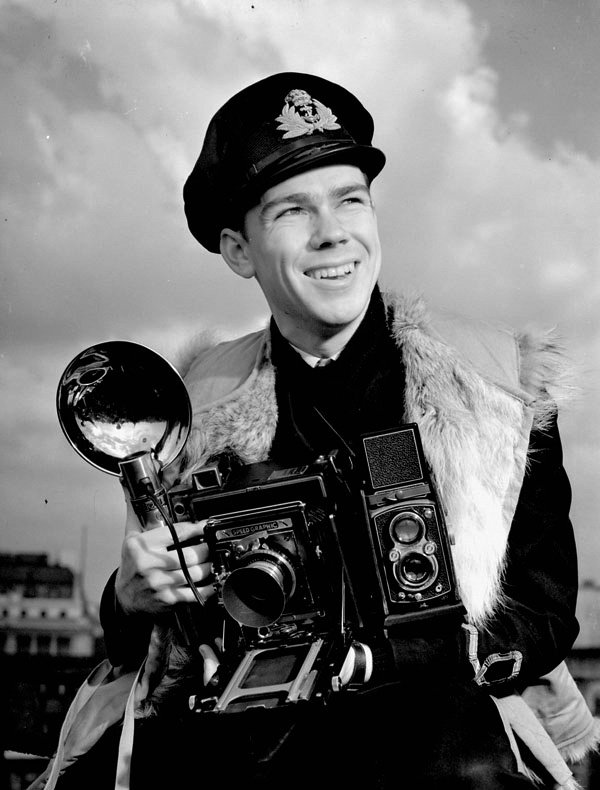
Perhaps the most famous Speed Graphic user was New York City press photographer Arthur “Weegee” Fellig, who covered the city in the 1930’s and 1940’s. Barbara Morgan also used a Speed Graphic to photograph Martha Graham’s choreography. And New York City-based photographer Louis Mendes has used a Speed Graphic for over forty years!
Pulitzer
The 1942-1953 Pulitzer Prizes for photography were taken with Speed Graphic cameras, including AP photographer Joe Rosenthal’s image of Marines raising the American flag on Iwo Jima in 1945. A few winning photographs after 1954 were taken with Rolleiflex or Kodak cameras. 1961 was the last Pulitzer Prize-winning photograph with a Speed Graphic, taken by Yasushi Nagao showing Otoya Yamaguchi assassinating Inejiro Asanuma on stage.
In 2004, American photojournalist David Burnett used his 4×5 inch Speed Graphic with a 178 mm f/2.5 Aero Ektar lens removed from a K-21 aerial camera to cover John Kerry’s presidential campaign. Burnett also used a 4×5 inch Speed Graphic to shoot images at the Winter and Summer Olympics. (proving they are still usable in the digital age)
Changing Manufacturers
The company name changed several times over the years as it was absorbed and then released by the Eastman Kodak Corporation, finally becoming a division of the Singer Corporation, and then dissolved in 1973. The award winning Graflex plant in Pittsford, New York is still standing and is home to Veramark Technologies, Inc., formerly known as the MOSCOM Corporation.
The Graphic back (also known as the “Spring Back”) retains the focusing screen and hood assembly to the back of the camera using a pair of wide flat springs. This permits cut film holders to be inserted between the focusing screen and hood assembly and the camera body. When the cut film holder is inserted, it pushes the focusing screen assembly back slightly. The tension of the springs holds the film holder in place.
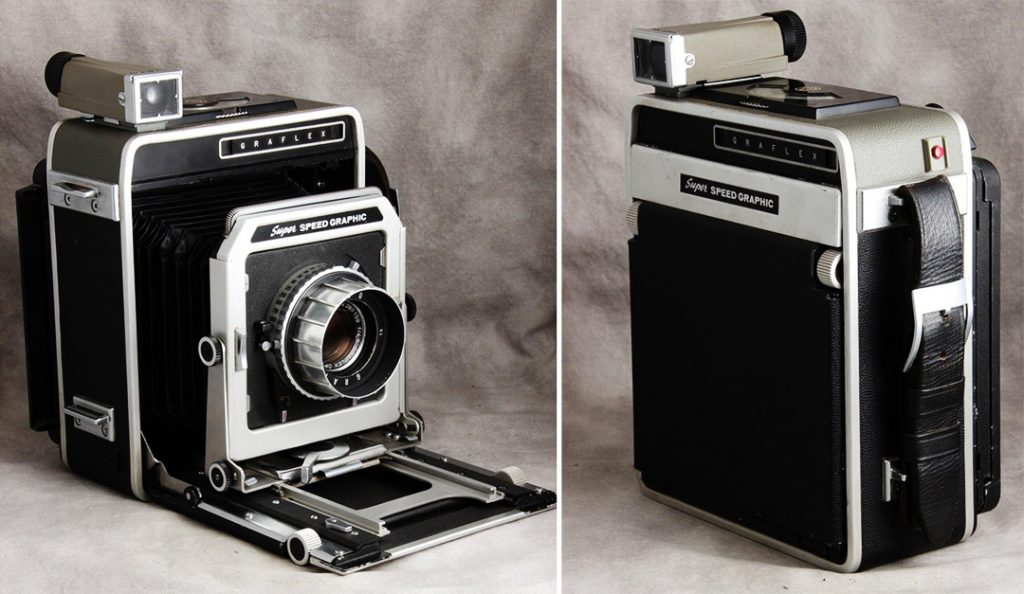
Focusing Screen
Because there is no mechanism (other than removing a pair of screws) to permit the focusing screen to be removed, roll film holders were made to slide in place and be retained by the focusing screen, just as with cut film holders. Some roll film holders were made with a “straight through” film path. These had the supply spool on one side and the take-up spool on the other.
This meant that the partially-assembled roll holder was inserted into the back and then the take-up side was assembled from the opposite (left) side. This type of roll film holder could not be removed until the roll was finished. Roll film holders with a “u-turn” film path were made. This type had the supply and take-up spools on the same side of the camera. They ran the film path over a roller. If supplied with a dark slide, they could be removed mid-roll.
Varied Configurations
The cast-magnesium Graflok back was introduced in 1949. “Anniversary” and “Pacemaker” models that were made with Graphic backs could have Graflok backs installed. (These backs are attached to the cameras with just four screws.) Graflok backs were sold by Graflex for this purpose. All “Century” models had the Graflok back molded as part of the body. The “Super Graphic” and “Super Speed Graphic” models have rotating Graflok backs. Graflok backs can accept accessories for either the Graphic or the Graflok back.
A sports finder was standard equipment on all Graflex press cameras. Parallax adjustment is on the hoop or the eyepiece, depending on model.
The Speed Graphics and their brethren, the Crown Graphic and Century Graphic are remarkable cameras capable of the highest quality of work. The Speed Graphic has not been manufactured since 1973 and most photographers today are unable to make a direct comparison. In many ways, the Speed Graphic was America’s first and last great camera.
Features,…and More Features
The Speed Graphic looks complicated, but is one of the simplest and most flexible cameras made. Afflicted by a “Rube Goldberg” variety of features, such as three viewfinders, you proved your skill every time you used it. Nothing in the Graphic is automated; if you don’t pay attention you can double expose, shoot blanks, fog previous exposures or shoot out of focus images. However, once you get used to it, it was amazingly easy to use.
The older Graflex SLR with its patented focal plane shutter and reflex focusing had been so successful as a press camera that the Graflex company set out to design a camera specifically for the emerging press photographer. The result was the original Speed Graphic of 1912.
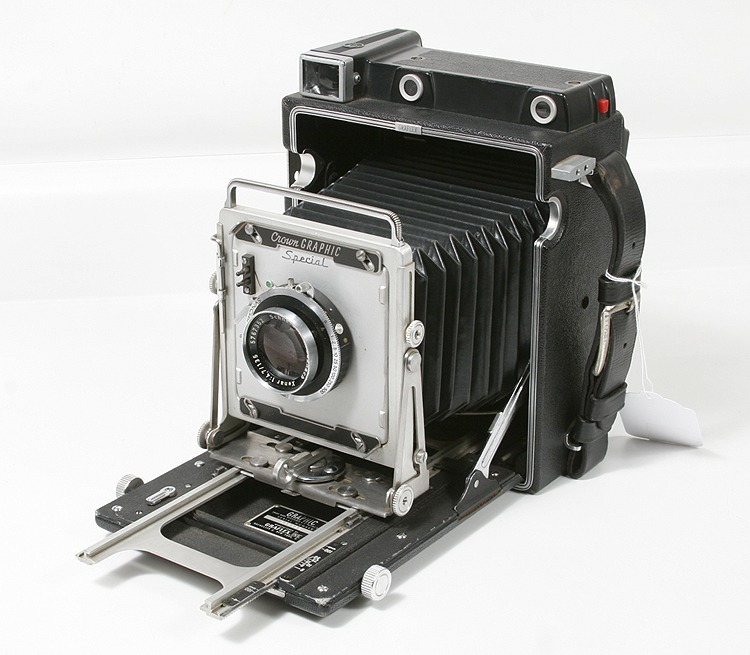
The concept of having two separate shutters was a new idea. The focal plane shutter was the same as used in the Graflex, the front in-lens shutter provided extra versatility. Because both shutters cannot be used at the same time, there is possibility of confusion. Experienced Speed Graphic users find selection of shutters second nature.
The Anniversary Speed Graphic
In 1940, Graflex announced the Anniversary Speed Graphic with Kodak Anastigmat (or the then all-new Ektar) lens. The new features included the coupled rangefinder and flash solenoid to use the then popular flashbulb. The bed would drop past horizontal, allowing the use of the new wide angle lenses.
The Speed Graphic was the still camera of World War II, and took many famous images striking today for their technical and artistic beauty. On the home front, Weegee, prowled the streets of New York with his Speed Graphic. He writes in his 1945 monograph Naked City: “The only camera I used was a 4×5 Speed Graphic with a Kodak Ektar lens in a Supermatic Shutter. All-American made. The film I used was Kodak Super-Panchro Press B. I always used a flashbulb for my pictures which were mostly taken at night.”
If you are puzzled about the kind of camera to buy, get a Speed Graphic… for two reasons… it is a good camera, and moreover… with a camera like that the cops will assume that you belong on the scene and will let you get behind police lines.”
In 1947, the Pacemaker Speed Graphic was introduced bristling with new features such as a body mounted shutter release and simplified focal plane shutter, now with 6 direct-reading normal speeds rather than the 24 tension/shutter combinations possible before.
The Graflok back, with a metal focusing hood and removable ground glass was introduced in 1949.
The Graflok Back
A Graflok back is now the standard for 4×5 view cameras today. The Graflok back accepts sheet film holders, “Grafmatic” 4×5 sheet film magazines, 120 roll film adapters, Polaroid backs, the Kodak ReadyLoad and Fuji QuickLoad backs, and the now-obsolete film pack.
The Speed Graphic, like other “press” cameras, was designed to be operated either handheld or on a tripod. With a Grafmatic, one could shoot six successive images, handheld, using shutter speeds as high as 1/1000 sec. While the reviewer in the video has slight complaints about the 75+ year old lens, there are many lenses available, including new ones with modern day coatings.
As foreign as most people would find this camera today, it is still capable of quite stunning images. A scanned 4×5 image is quite glorious, and there are still many “artists” who use this camera. And it’s quite cheap in the second hand market! Find Speed Graphic or Find Crown Graphic

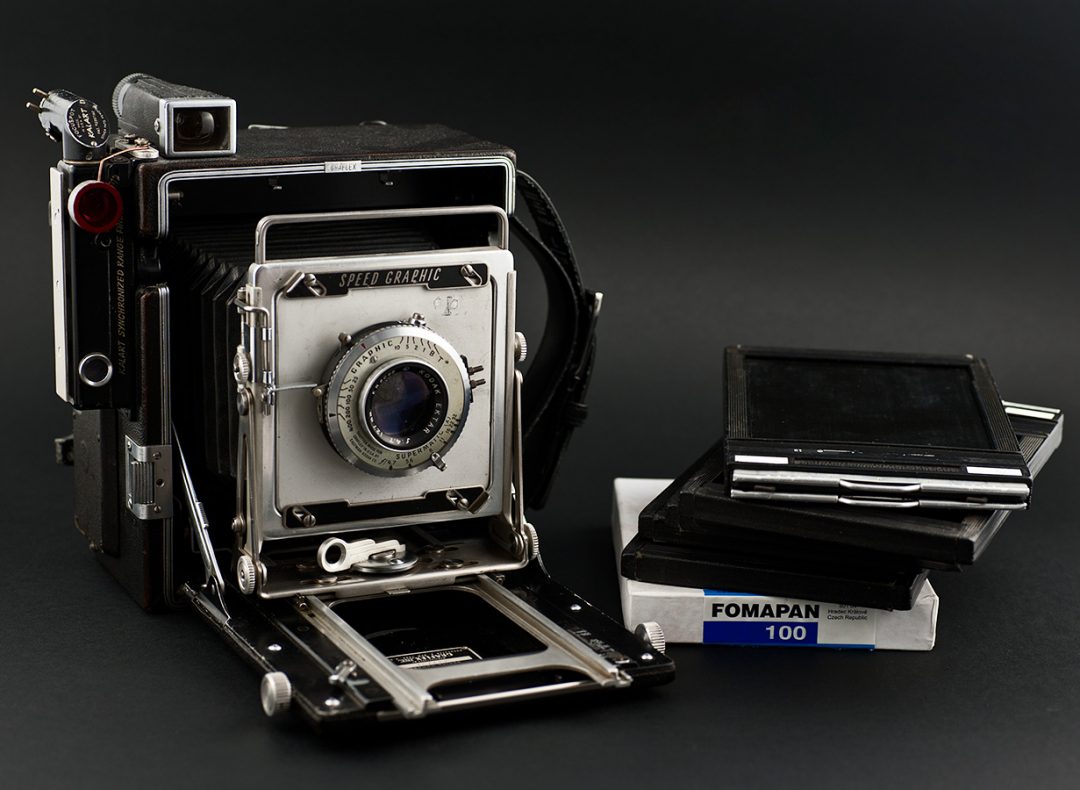
Sorry you had problems with the shutter. By the way, do you develop film?. I’d like to get my hands on a Speed Graphic.
Hi Barry,
No, we don’t. While I develop ALL my own black and white, on the rare occasion I shoot color, I use the Darkroom. ( https://thedarkroom.com/ ) https://www.richardphotolab.com/ is also quite good with color. In the US. Speed Graphics are quite affordable on Ebay right now. If you’re going 4×5, make sure you get one with a Graflok back.
Cheers
One reason that I like Speed and Crown Graphics is that they are rugged as Hell and remind me of an Alligator Snapping Turtle.